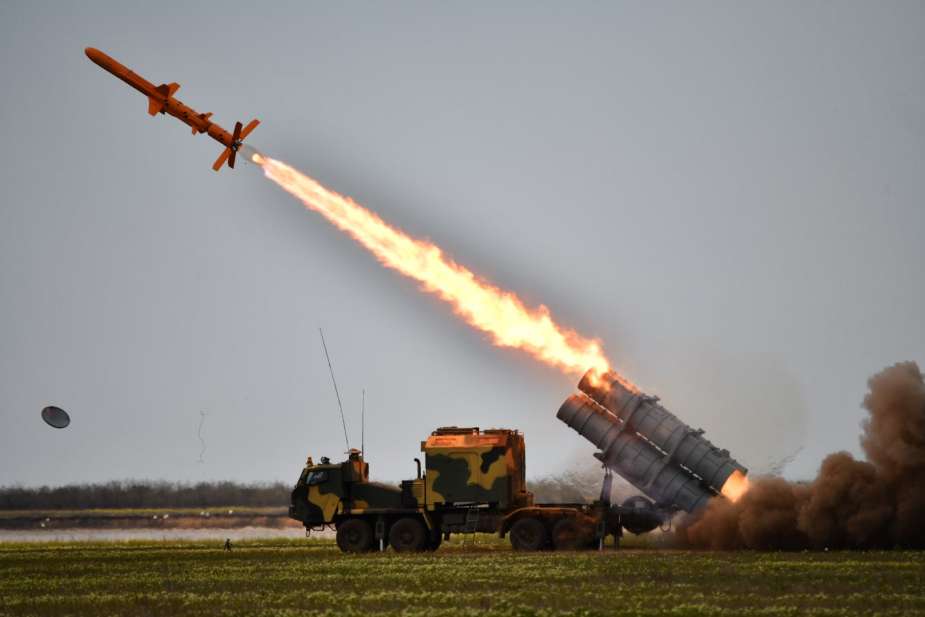In the ongoing series examining military hardware in the Russian-Ukrainian conflict, Army Recognition presents the fifth episode, focused on the Neptune missile system. Developed by Ukraine to increase its naval defense capabilities against Russia, the Neptune system gained attention following its involvement in the sinking of the Russian cruiser Moskva in 2022, highlighting its impact on the Russian Black Sea Fleet.
Follow Army Recognition on Google News at this link

Since its introduction in 2021, the Neptune anti-ship missile had a major impact on the Russian Navy's Black Sea Fleet. (Picture source: Ukrainian MoD)
The Neptune missile system, developed by the Luch State Kyiv Design Bureau, represents a significant step forward in Ukraine's naval defense capabilities against Russia since its incorporation into Ukraine's arsenal in March 2021. Inspired by the Soviet-era Kh-35 missile, the Neptune is designed to target a variety of naval vessels including cruisers, destroyers, frigates, corvettes, and transport ships, accommodating both individual and group operations, and aims to counter electronic and fire defenses posed by potential adversaries.
The most notable use of the Neptune missile occurred on April 13, 2022, when the Russian cruiser Moskva was reportedly hit by two such missiles, resulting in the vessel's sinking while demonstrating the missile's effectiveness. This marked a significant event as the Moskva, the flagship of the Russian Black Sea Fleet, was the largest Russian warship to be sunk in wartime since World War II, and the first Russian flagship to be sunk since the Russo-Japanese War in 1905.
This engagement contributed to an increase in Ukrainian confidence and demonstrated to Ukraine's allies the potential benefits of providing further military assistance to the country. Subsequently, Ukraine initiated modifications to the Neptune missile to enhance its capability to target land-based objectives, broadening its operational versatility beyond maritime applications. Moreover, this event radically changed the strategic situation in the Black Sea.
Following the sinking of the Moskva, there has been a noticeable shift in the operational behavior of the Russian Black Sea Fleet, which has been forced to adopt a more defensive posture, staying well offshore to avoid further Ukrainian missile attacks, thus limiting the possibilities of the Russian Navy to launch missile attacks against Ukrainian cities.
To maintain this advantage, the mobility of the Neptune system was considered crucial by the Ukrainian army. It can be deployed up to 25 kilometers from the coastline and made operational at a new site within approximately 15 minutes. This feature is intended to enable rapid response to threats and minimize the time available for enemy counteractions, thereby potentially enhancing its utility in defensive operations.
A possible reason explaining the sinking of the Moskva is the capacity of the Neptune system to launch up to 16 missiles in a single salvo, with intervals of 3 to 5 seconds between launches, allowing it to overwhelm its target's anti-missile defense systems. The design also focuses on low-altitude missile flight during the terminal phase — between 3 to 10 meters above the sea — to reduce detection by radar systems and potentially increase the likelihood of reaching the target.
The system's standard architecture comprises an RKP-360 mobile command post, a set of 48 R-360 missiles within TPK-360 transport-launch containers, four USPU-360 unified launchers, and four each of TZM-360 transport and loading vehicles and TM-360 transport vehicles, supplemented by necessary ground equipment. Initially utilizing Ukrainian-made KrAZ chassis, subsequent evaluations led to the adoption of the Czech Tatra 815-7 chassis in both 6x6 and 8x8 configurations, following performance testing.
The R-360 missile, with its diameter of 420 mm and a warhead weighing 150 kg, is an integral component of the Neptune system, which can carry up to 72 of these missiles and launch up to 24 simultaneously depending of the USPU-360 number. These missiles are equipped with an active radar seeker, providing the functionality for missile guidance and the capacity to track and engage with moving naval targets over a range of 7 to 300 kilometers. Each missile is programmable, allowing for the input of up to eight waypoints, which assists in navigation around defensive measures or geographical features during its course. Its design is specifically tailored for compatibility with the TPK-360 transport and launch container, which contributes to efficient transport and facilitates the missile's readiness for deployment.
The closest Russian counterpart to the Ukrainian Neptune anti-ship missile is the Kh-35 (also known as Uran), which is a Soviet-origin subsonic anti-ship cruise missile, launched from various platforms including helicopters, surface ships, and coastal defense batteries. It entered Russian Navy service in 2003 and features a turbojet engine, designed to attack vessels up to 5,000 tonnes, a displacement half the size of the Moskva. The missile is known for its low-flying, sea-skimming capabilities, enhancing stealth and reducing detection by enemy radar.
















